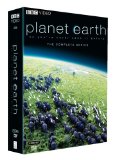| Reviews & Columns |
|
Reviews DVD TV on DVD Blu-ray 4K UHD International DVDs In Theaters Reviews by Studio Video Games Features Collector Series DVDs Easter Egg Database Interviews DVD Talk Radio Feature Articles Columns Anime Talk DVD Savant Horror DVDs The M.O.D. Squad Art House HD Talk Silent DVD
|
DVD Talk Forum |
|
|
| Resources |
|
DVD Price Search Customer Service #'s RCE Info Links |
|
Columns
|
|
|
Planet Earth: The Complete BBC Series (5-Disc Set)
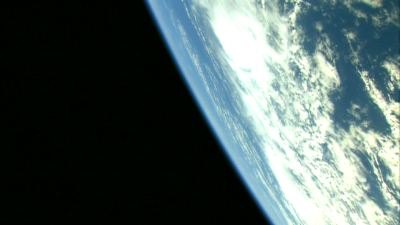
It's not every day that a documentary series dubs itself "the definitive look at the diversity of our planet", but BBC's landmark Planet Earth (2006) does a fantastic job of backing up its claims. Assembled over a four-year period and spanning more than 60 countries, this globetrotting production stands tall as the first nature documentary filmed entirely in a high-definition format. This wouldn't just ensure stunning visuals, but it would also take the genre to new investigative heights: by filming from greater distances, the wildlife on display would remain generally undisturbed. Previously unseen behavior patterns and rituals could finally be observed and preserved...and not a moment too soon, because some of our featured stars may not be around for much longer.
Leisurely paced, densely informative and rich in color, Planet Earth packs each of its 11 episodes with equal parts education and entertainment. Narrated by BBC mainstay David Attenborough, we're treated to a vast array of species, exotic locations and stunning time-lapse photography. Each episode has been paired with a 10-minute segment of "Planet Earth Diaries", which documents unusually tough sequences from the perspective of the hard-working filmmakers. For the most part, though, Planet Earth is almost completely human-free, making the few exceptions almost jarring in comparison.
The focus of this ambitious 11-part series remains steady throughout, reminding us how much of our planet has yet to be discovered. From the great heights of the Himalayas to the depths of crystal-lined caverns and everything in-between, Planet Earth is an eye-opening experience for nature lovers of all ages.
Though the stunning visuals and steady narration are potent enough on their own terms, George Fenston's sweeping score also deserves special mention. Over two hours' worth of music highlights the production, pairing well with the chatters and chirps, sweeping winds, rustling leaves, fierce snowstorms and rumbling avalanches. If you're interested in hearing it on its own terms, a two-disc soundtrack compilation is available separately.
Originally broadcast in the UK over a year ago, this critically and commercially successful series made quite the domestic splash on the Discovery Channel when it first aired roughly a month ago. Attenborough's narration was completely dubbed over by actress/conservationist Sigourney Weaver---and though her rendition is capable enough, Planet Earth sounds the most natural in its original format. Less forgivable, however, was Discovery's trimming of several scenes for commercial time and content. Luckily, fans of Planet Earth needn't worry about either alteration: Attenborough's narration plays over every original, full-length episode on this five-disc set, though the Discovery Channel's abridged version is also available via their official website. For now, let's take a closer look at what's included here, shall we?
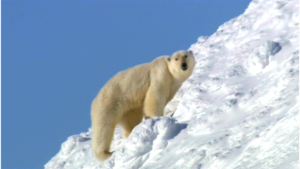
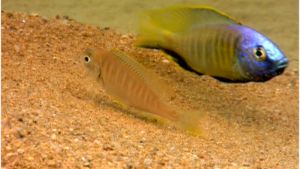


"From Pole to Pole" (above left) gets the series off to a strong start, providing a modest "highlight reel" of upcoming sequences without spoiling all the surprises. Gradual climate changes and seasonal transitions are often shown using time-lapse photography, from the chilly Antarctic landscape northward. Polar bear cubs are shown taking their first steps alongside their mother, while the journey of emperor penguins is also documented in modest detail. A thrilling chase sequence also arrives early on, as migrating Canadian caribou are hunted by a pack of hungry wolves. Other highlights include footage of rare Amur leopards in eastern Russia, a spectacular slow-mo sequence of a Great White Shark catching a seal in midair, New Guinea's birds of paradise and the stealthy hunting tactics of African hunting dogs.
"Mountains" is up next, briefly touching upon the majority of our planet's major ranges. An early sequence shows us the ever-changing weather conditions of the Andes, home to guanacos, pumas and other durable species. One of Planet Earth's most thrilling chases is also captured during this episode: a rarely-seen snow leopard pursues its prey on a snow-covered hillside, deftly jumping across rocks to secure food for her year-old cub. Grizzly bears are also shown at home in the Rocky Mountains, as young cubs emerge from their den and play alongside their patient mother. Other highlights include a demoiselle crane hunt by golden eagles near Mount Everest, footage of a giant panda nursing her tiny young cub and Pakistan's Baltoro glacier, roughly 43 miles in length.
"Fresh Water" (above right) takes us on a leisurely tour of rivers and lakes that each support a vast array of species. Interestingly enough, it's mentioned that only 3% of the planet's water is fresh, though nearly all life eventually requires it to survive. An early highlight is seen during helicopter footage of Angel Falls, the world's highest free-flowing waterfall at roughly 3,000 feet high. The Grand Canyon is also covered in modest detail, shown as an example of how water can gradually erode and shape the landscape around it. We also stop in the waters of Japan, greeted by six-foot long giant salamanders and salmon-hunting grizzly bears. Other notable segments include a battle between otters and crocodiles, a tour of the Nile and a quest to film hungry piranhas in tropical Brazil.
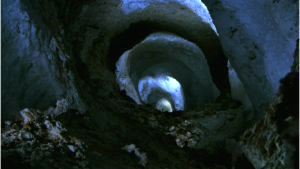
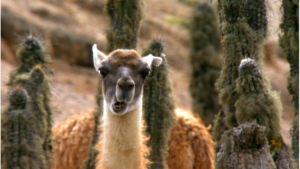

"Caves" (above left) informs us that these dark dwellings are perhaps some of our planet's least-explored areas (aside from the ocean, one would think), so there's plenty to dig through. Our attention is grabbed almost immediately as explorers are shown diving into Mexico's 1200-foot deep Cave of Swallows. Borneo's Deer Cave is another early highlight, showcasing a 300-foot high mound of wrinkle-lipped bat droppings covered with hungry cockroaches (yum!). The centerpiece of this episode, however, is a guided tour of the newly-discovered Lechuguilla Cave in New Mexico, which took roughly two years of legal coaxing to secure filming rights (additionally, this may be the only trip ever allowed by local authorities). Lechuguilla is home to vast amounts of sulfuric acid, which create unique crystal formations over time---and once you see how many are on display in "The Chandelier Ballroom", you'll see why it took so long to get in. Other highlights include footage of animals accustomed to the extreme darkness, including a peculiar eyeless cave salamander.
"Deserts" (above right) takes us to several of our planet's driest environments; first up, we make a brief stop at the Gobi in Mongolia. The extreme temperatures are inhospitable at both ends of the thermometer, though a select handful of species have become accustomed to the weather. One such hardy beast is the Bactrian camel, who munches on snow to prevent dehydration...but excessive amounts can prove to be fatal. The Sahara desert is another early stop, where gigantic sandstorms stop all but a few in their tracks. We also catch glimpses of animals not usually associated with deserts, including elephants, lions and red kangaroos. The latter prove to be especially clever in the harsh environment, cooling themselves by licking their foreams at shaded rest stops.
"Worlds of Ice" shows us the extreme opposite, focusing solely on life at both of our planet's poles. Antarctica is up first, where we're told up front that it contains roughly 90% of the planet's ice; despite the raw climate, though, it's home to plenty of familiar faces. The continent's drastic shape-shifting---which takes place from winter to summer---is shown via time-lapse photography, while the latter shows humpback whales hunting krill by using a clever trap of circular bubbles. Emperor penguins, covered in modest detail during the first episode, are also followed on their long journey from mating grounds to family reunions in the summer. The Arctic is also touched upon, where another previous segment (the adventures of two polar bear cubs and their mother) is covered in more detail. Perhaps the most emotionally-charged sequence, however, follows a hungry male polar bear in search of food. Exhausted from swimming a great distance, he desperately resorts to attacking a nearby walrus colony.

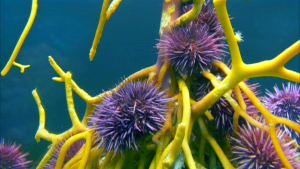

"Great Plains" is next, standing tall as a truly exceptional episode from start to finish. We've got an unusual subject in the spotlight (grass!), which ranks as one of our planet's most durable as valuable plants. This is first displayed as we travel to Outer Mongolia, where a raging brush fire---brought on by a lightning storm---displaces a herd of grazing gazelle, though the lush green meadow quickly repairs itself. Up north, migrating snow geese are terrorized by hungry Arctic foxes, while herds of caribou have wolves to deal with. We also move on to the tall grasses of India, high enough to camouflage large elephants and miniature pygmy hogs alike. Elephants are also included in one of Planet Earth's most thrilling sequences, as a herd of African elephants is forced to share a waterhole with starving lions. The pride makes a desperate attack during the night, showing a rarely-seen behavior that plays well on film...thanks to the magic of infrared camera lights.
"Jungles" (above left) takes us to more tropical environments; reportedly, half of our planet's species live there despite occupying only 3% of the surface area. New Guinea proves to be an early highlight, where local birds of paradise perform bizarre and elaborate dances to attract potential mates. In one instance, a bird is shown cleaning his living area in preparation for his "blind date". Elsewhere, the various layers of typical rainforests are covered in modest detail, from the dark floors to the highest canopies. The latter is of particular interest, where over 40 different species are shown working shifts to eat at a popular fig tree. Other highlights include a look at crafty pitcher plants, roaming elephants dining on hard-to-reach clay minerals and a huge gang of primates fighting for territorial rights.
"Shallow Seas" (above right) is the first of Planet Earth's main explorations of underwater habitats, showing us what lies in the oceans immediately surrounding our planet's continents. This includes more footage of humpback whales and their family lives, which shows parents feeding their hungry calves roughly 200 gallons of milk each day. Indonesia and Australia are also highlighted, where fish partner up for hunting and dolphins search for food in shallow waters. Later on, we stop at southern Africa, where squid are hunted by stingray and great white sharks feed on fleeing seals. Other highlights include algae kick-starting the Persian Gulf's food chain and king penguins tiptoeing through beaches lined with angry fur seals.
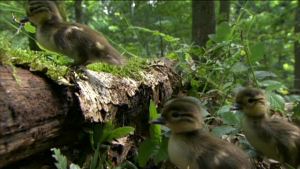
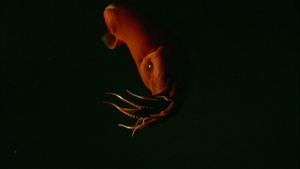

"Seasonal Forests" (above left) may be the environment most viewers should be familiar with, but there's still much to learn along the way. We start in the slightly more unfamiliar world of the Arctic; vast numbers of conifer trees are shown spreading across our planet, but our first major stop is in the Pacific Northwest. Redwoods are also covered in modest detail, as the world's tallest trees share space with hunting pine martens and gray owls. We also briefly explore America's East Coast and the explosion of cicadas, as well as another trip to eastern Russian to glimpse the Amur leopard. Other highlights include an unlucky monkey falling victim to a tiger, moose and wolverines braving the cold and bouncing baby ducklings.
"Ocean Deep" (above right) closes the series, plunging into some of our planet's least explored areas. Footage of scavenging dolphins proves to be an early highlight, who work in large groups to obtain their food. Undersea volcanoes are also briefly touched upon, believed to be roughly 30,000 in number...with some of them taller than the world's highest mountains. We also get to see footage of the blue whale, our planet's largest animal, on the rapid road to extinction. Other marine-dwelling species shown include bait fish (who employ a whale shark as protection), scavenging spider crabs and color-changing sailfish. Though there's an unfortunate shortage of creepy deep-sea critters, those who enjoy underwater goings-on should be satisfied.
The final episode closes the series with a subtle reminder that the survival of many species remains largely on our shoulders. With that said, Planet Earth thankfully doesn't resort to scare tactics and guilt trips, instead serving as a collage of the wonderful environments that still exist on our planet. The fifth disc changes gears a bit, though fans of the series will certainly want to wade though every last bit of information.

This bonus disc---exclusive to this SD-DVD release, apparently---includes "Saving Species", "Into the Wilderness" and "Living Together", three additional documentaries running just under an hour each. Covered in more detail below (under "Bonus Features"), these programs provide a more forward-thinking perspective of the world's ever-changing ecosystems, complementing the 11-part series quite nicely. In the meantime, let's take a look at the technical department.


Presented in its original 1.78:1 aspect ratio, Planet Earth has been enhanced for widescreen displays. The color palette is bold and black levels are solid, but the overall image quality is quite lacking in certain respects. Digital combing is easily spotted during many fast-paced sequences [Sample #1 - "The Hunt Is On"], while pixellation, compression artifacts and edge enhancement are most noticeable during crowded compositions [Sample #2 - "A Flock of Birds"]. Planet Earth obviously involved a great deal of time and effort to assemble, which makes these digital blemishes all the more frustrating. One can only assume that the HD-DVD and Blu-ray releases are substantially crisper and more detailed, because what's here almost ruins the entire production. In an otherwise well-rounded release, this remains the largest disappointment by far.
The included Dolby Digital 5.1 mix, on the other hand, isn't disappointing at all. Planet Earth's enveloping atmosphere is preserved in great detail, boasting plenty of surround activity and strong channel separation. From distant bird calls to the rush of powerful winds and snowstorms, this is easily one of the best-sounding documentaries around. Attenborough's narration occasionally fights for attention with the powerful score, but a satisfying balance is usually maintained. English captions, as well as Spanish and French subtitles, are provided for the main feature and bonus material.
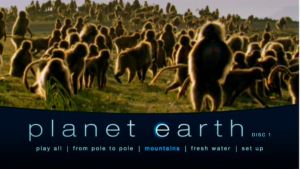
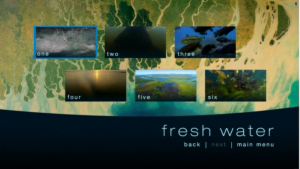

Seen above, the animated menu designs are basic and easy to navigate. Each 58-minute episode (including the 10-minute Planet Earth Diaries, detailed below) has been divided into 6 chapters, while no obvious layer changes were detected during playback. This five-disc release is housed in a foil-enhanced foldout digipak case; no inserts have been included, though episode summaries are printed behind each clear tray.

As mentioned earlier, each episode has been paired with a 10-minute installment of "Planet Earth Diaries" (11 sections, 110 minutes total), giving viewers a brief look behind-the-scenes view of particular sequences from each episode. These featurettes are fascinating to watch, providing strong reminders of how difficult it must've been to acquire such terrific footage. Highlights include cave explorers covered in bat droppings and cockroaches, the pitch-black filming of hungry lions vs. an elephant (below left), a chilly encounter with a stubborn polar bear, the search for snow leopards and much, much more. After each 48-minute episode, it's almost jarring to see humans in front of the camera---but if that isn't a testament to Planet Earth's spellbinding focus, what is?
The fifth disc is home to the remaining extras, a series of Bonus Documentaries that include "Saving Species", "Into the Wilderness" and "Living Together" (roughly 150 minutes total, below right). Originally aired on the BBC alongside Planet Earth, these additional programs are narrated by Simon Poland and look towards our planet's future. Intermixed with this theme, however, is additional behind-the-scenes footage and retrospective comments by members of the cast and crew.
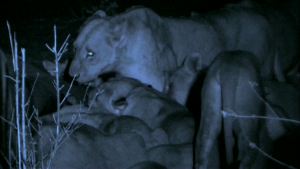
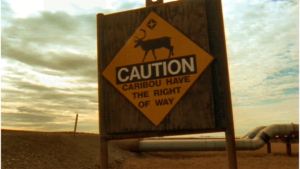
Weighing the ever-growing problems of deforestation, climate changes and growing extinction rates, this three-part series (dubbed "Planet Earth: The Future" on the packaging) offers equal parts explanation and preventative measures currently being put into practice. Protected areas are also briefly explored, as guarded coral reefs and wildlife refuges are presented as ways to prevent further damage to certain ecosystems and species. All things considered, it's impossible to produce a series of this magnitude without reflecting on how humans have changed things, so "The Future" should be considered essential viewing for those who enjoyed Planet Earth.
All bonus features are presented in anamorphic widescreen and include the same subtitle options as the main feature. Though it's odd that both high-definition releases don't include the bonus disc, we can only assume it was to keep prices competitive with this standard package. Either way, Planet Earth has already proven to be a huge seller, and for good reason: it's undoubtedly one of the best nature documentaries you're likely to see in any format.

It's not often that nature documentaries obtain widespread public attention, but Planet Earth astounds audiences with spectacular sights and an amazing atmosphere. This 11-part series dissects areas of our planet seldom seen in such detail, highlighting countless new species and their curious behavioral patterns...but it's not just educational, it's supremely entertaining. BBC's DVD package, while sadly lacking in the visual department, delivers an exceptional audio presentation and an assortment of valuable extras. Though it's not polished enough to earn a higher rating, Planet Earth should still be considered a worthwhile purchase that the whole family will enjoy. Videophiles should certainly opt for the high-def versions, but most everyone else should still consider this release Recommended. The material's simply too good to ignore.
Randy Miller III is an affable office monkey based in Harrisburg, PA. He also does freelance graphic design projects and works in a local gallery. When he's not doing that, he enjoys slacking off, second-guessing himself and writing things in third person.
|
| Popular Reviews |
| Sponsored Links |
|
|
| Sponsored Links |
|
|
| Release List | Reviews | Shop | Newsletter | Forum | DVD Giveaways | Blu-Ray | Advertise |
|
Copyright 2024 DVDTalk.com All Rights Reserved. Legal Info, Privacy Policy, Terms of Use,
Manage Preferences,
Your Privacy Choices | |||||||









